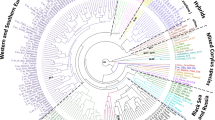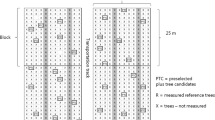Abstract
The widespread European forest tree Fagus sylvatica L. is of great importance for forest management. However, information about seed dispersal is still very rare, though important for harvesting strategies and later on seed source identification. We refined a DNA fingerprinting method for beech nut shells in order to directly assign dispersed seeds to their mother trees. A pilot study was conducted in two beech stands in Germany where leaves of the adult trees and the exocarp of dispersed seeds were fingerprinted at six nSSR loci. While one stand was randomly analysed for adults and dispersed seeds the other was systematically investigated following common harvesting procedures. Imitating the typical net harvesting strategy, seeds were collected beneath 19 adult trees. Exocarp genotyping revealed that on average three different mother trees contributed to a sample of five or six seeds collected beneath a single adult tree. Of the identified mother trees most were located within a radius of 15 m from the sampling point. The repeated pattern of seed dispersal within a short distance constitutes the basis for a straightforward strategy for the assignment of seed lots to a seed source stand. This strategy is based on the matching of individual genotypes without the necessity for a full inventory of the putative source stand. Additionally, we provide allelic ladders of five nSSR loci for standardization among laboratories.


Similar content being viewed by others
References
Butler JM, Shen Y, McCord BR (2003) The development of reduced size STR amplicons as tools for analysis of degraded DNA. J Forensic Sci 48:1054–1064
Chybicki IJ, Trojankiewicz M, Andrzej O, Dzialuk A, Burczyk J (2009) Isolation-by-distance within naturally established populations of European beech (Fagus sylvatica). Botany 87(8):791–798
Craft KJ, Owens JD, Ashley MV (2007) Application of plant DNA markers in forensic botany: genetic comparison of Quercus evidence leaves to crime scene trees using microsatellites. Forensic Sci Int 165:64–70
Cuguen J, Merzeau D, Thiébaut B (1988) Genetic structure of the European beech stands (Fagus sylvatica L.): F-statistics and importance of mating system characteristics in their evolution. Heredity 60:91–100
de Valk HA, Meis JFGM, Betagne S, Costa J-M, Lasker BA, Balajee SA, Pasqualotto AC, Anderson MJ, Alcázar-Fuoli L, Mellado E, Klaassen CHW (2009) Interlaboratory reproducibility of a microsatellite-based typing assay for Aspergillus fumigatus through the use of allelic ladders: proof of concept. Clin Microbiol Infect 15:180–187
Dounavi A (2000) Familienstrukturen in Buchenbeständen (Fagus sylvatica). Dissertation, Georg-August-Universität Göttingen
Dumolin S, Demesure B, Petit RJ (1995) Inheritance of chloroplast and mitochondrial genomes in pedunculate oak investigated with an efficient PCR method. Theor Appl Genet 91:1253–1256
Ellenberg H (1996) Vegetation Mitteleuropas und der Alpen. Ulmer, Stuttgart
Forstamt Hilchenbach (1996) Bestandesblätter FBB Hohenroth. pp 297–304
Forsteinrichtung Stadtwald Hallenberg (1993) Bestandesblätter 1-317. pp 64–71
Grivet D, Smouse PE, Sork VL (2005) A novel approach to an old problem: tracking dispersed seeds. Mol Ecol 14:3585–3595
Hartl DL, Clark AG (2007) Principles of population genetics, 4th edn. Sinauer Associates Inc., Sunderland
Hegi G (1983) Illustrierte Flora von Mitteleuropa, Band 1. Verlag Paul Parey, Berlin
Hussendörfer E (2005) ZüF–eine erste Bewertung aus Sicht der Zertifizierungsstelle. AFZ–Der Wald 5: 226–227
Konnert M (1995) Investigations on the genetic variation of beech (Fagus sylvatica) in Bavaria. Silvae Genet 44(5–6):346–351
Konnert M, Behm A (2006) Proof of identity of forest reproductive material based on reference samples. Mitt Bundesforsch 221:61–71
Konnert M, Hussendörfer E (2002) Provenance identification of forest reproductive material using reference samples. Allg Forst- u J-Ztg 173:97–104
Magri D, Vendramin GG, Comps B, Dupanloup I, Geburek T, Gomory D, Latolowa M, Litt T, Paule L, Roure JM, Tantau I, van der Knaap WO, Petit RJ, de Beaulieu JL (2006) A new scenario for the quaternary history of European beech populations: paleobotanical evidence and genetic consequences. New Phytol 171(1):199–221
Merzeau D, Comps B, Thiébaut B, Cuguen J, Letouzey J (1994) Genetic structure of natural stands of Fagus sylvatica L (beech). Heredity 72:269–277
Müller-Schneider P (1977) Verbreitungsbiologie (Diasporologie) der Blütenpflanzen. Veröff Geobot Inst ETH, Stiftung Rübel 61, Zürich
Pastorelli R, Smulders MJM, Van′t Westende WPC, Vosman B, Giannini R, Vettori C, Vendramin GG (2003) Characterization of microsatellite markers in Fagus sylvatica L. and Fagus orientalis Lipsky. Mol Ecol Notes 3: 76–78
Peakall R, Smouse PE (2006) GENALEX 6: genetic analysis in Excel. Population genetic software for teaching and research. Mol Ecol Notes 6: 288–295 Available from: http://www.anu.edu.au/BoZo/GenAlEx/
Schubert R, Hilbig W, Klotz S (2001) Bestimmungsbuch der Pflanzengesellschaften Deutschlands. Spektrum Akademischer Verlag Heidelberg, Berlin
Schueler S, Tusch A, Schuster M, Ziegenhagen B (2003) Characterization of microsatellites in wild and sweet cherry (Prunus avium L.)–markers for individual identification and reproductive processes. Genome 46:95–102
Sitte P, Weiler EW, Kadereit JW, Bresinsky A, Körner C (2008) Lehrbuch der Botanik für Hochschulen. Spektrum Akademischer Verlag Heidelberg, Berlin
Taberlet P, Luikart G (1999) Non-invasive genetic sampling and individual identification. Biol J Linn Soc 68:41–55
Tanaka K, Tsumura Y, Nakamura T (1999) Development and polymorphism of microsatellite markers for Fagus crenata and the closely related species F. japonica. Theor Appl Genet 99:11–15
Vollrath B (2005) Autochthonie im Praxistest—vergleichende Untersuchungen bei Gehölzanpflanzungen. In: Forstliche Genressourcen als Produktionsfaktor, 26. Tagung der Arbeitsgemeinschaft Forstgenetik und Forstpflanzenzüchtung. 20.-22.10.2005, Fuldatal, Germany
Vornam B, Decarli N, Gailing O (2004) Spatial distribution of genetic variation in a natural beech stand (Fagus sylvatica L.) based on microsatellite markers. Conserv Genet 5:561–570
Waits LP, Luikart G, Taberlet P (2001) Estimating the probability of identity among genotypes in natural populations: cautions and guidelines. Mol Ecol 10:249–256
Watt AS (1925) On the ecology of British beechwoods with special reference to their regeneration, Part II (continued). J Ecol 13:27–73
Wypukol H, Liepelt S, Ziegenhagen B, Gebhardt K (2008) Genetische Methoden zur Abstammungsanalyse und Prüfung von Sortenechtheit und–reinheit. In: K. Gebhardt (Hrsg.) Herkunftskontrolle an forstlichem Vermehrungsgut mit Stabilisotopen und genetischen Methoden. Nordwestdeutsche Forstliche Versuchsanstalt, Hann. Münden, pp 67–84
Ziegenhagen B, Guillemaut P, Scholz F (1993) A procedure for mini-preparations of genomic DNA from needles of silver fir (Abies alba Mill.). Plant Mol Biol Reptr 11:117–121
Ziegenhagen B, Liepelt S, Kuhlenkamp V, Fladung M (2003) Molecular identification of individual oak and fir trees from maternal tissues of their fruits or seeds. Trees 17:345–350
Acknowledgments
We are grateful to Joachim Heyder of the Landesbetrieb Wald und Holz, NRW, Außenstelle Arnsberg-Obereimer and to Manfred Gertz of the Forestry Department Siegen-Wittgenstein for providing help and information about the analysed stands. Furthermore, we thank Martin Rogge of the Landesbetrieb Wald und Holz, NRW, Außenstelle Arnsberg-Obereimer for contributing his knowledge and experience in seed source control procedures. This study was co-financed by the Ministry of Nature Conservation, Agriculture and Consumer Protection, North-Rhine Westfalia, Germany. The construction of allelic ladders was co-financed by the EU Network of Excellence EVOLTREE.
Author information
Authors and Affiliations
Corresponding author
Additional information
Communicated by R. Matyssek.
Rights and permissions
About this article
Cite this article
Hasenkamp, N., Ziegenhagen, B., Mengel, C. et al. Towards a DNA marker assisted seed source identification: a pilot study in European beech (Fagus sylvatica L.). Eur J Forest Res 130, 513–519 (2011). https://doi.org/10.1007/s10342-010-0439-3
Received:
Revised:
Accepted:
Published:
Issue Date:
DOI: https://doi.org/10.1007/s10342-010-0439-3




